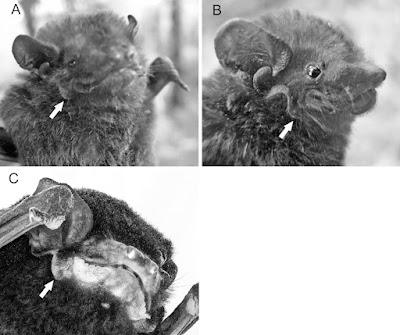Abstract
The Hoary Bat Chalinolobus nigrogriseus is the only species of the genus known from the island of New Guinea. A new species of Chalinolobus from Papua New Guinea is described based on DNA sequence and morphological criteria using material previously assigned to C. nigrogriseus. The new species most resembles the eastern Australian subspecies of the Hoary Bat C. n. nigrogriseus in general size and appearance but is easily distinguished by an enlarged, rather than rudimentary lobe at the terminal outer ear margin. The new species might also be confused on external characters with smaller individuals of Australian Gould’s Wattle Bat C. gouldii, from which it differs in having bifid first upper incisors and uniform dark dorsal fur. The inclusion of C. nigrogriseus in the bat fauna of New Guinea is now in doubt, pending a re-assessment of the identity of Chalinolobus specimens in world museum collections. Locality records of all Chalinolobus spp. from Papua New Guinea are reviewed. Most localities are below 60 m elevation in coastal savannah and woodlands. The identity of specimens of C. nigrogriseus and C. gouldii from northern Australia should be reviewed to determine whether the new species also occurs in Australia.
Mammalia, Chalinolobus nigrogriseus, Chalinolobus gouldii, Trans-Fly, savannah, woodland, taxonomy, morphology, genetics
 |
| Holotype of Chalinolobus orarius sp. nov., AM M.15114 adult male from Port Moresby, PNG. (Photo: Ron Lovatt, AM Digivols). |
Chalinolobus orarius sp. nov.
Diagnosis. Distinguished from all other species of Chalinolobus by the combination of an enlarged ear margin which terminates as a lobe near the angle of the mouth (Fig. 8), and the presence of a secondary cusp on I1 (Fig. 9). Further differentiated by DNA sequence divergence of at least 6.7% in the mtDNA COI gene from other sampled Chalinolobus species. Distinguished from Australian C. gouldii gouldii, C. gouldii venatoris and Norfolk Island C. cf. gouldii, the only other Chalinolobus in which the enlarged ear terminal lobe is present, by smaller mean body size, e.g. mean FA = 37.24 mm (n = 8 females) vs. northern Australian C. gouldii 40.97 mm (n = 66 females) (Table 4). Northern Australian C. gouldii (north of latitude 20° S) of equivalent forearm length to C. orarius sp. nov. tend to have larger skulls, e.g. CON typically greater than 12.9 mm, C1–C1 usually greater than 4.8 mm and CM3 greater than 5.0 mm (Table 3).
Etymology. Derived from the Greek adjective oraria meaning “of the coast”, a reference to the species distribution in the coastal and subcoastal eucalypt savannahs of southern New Guinea.
Common name. Coastal Lobe-lipped Bat is suggested as a vernacular name for this species.
Harry E. Parnaby, Andrew G. King, Steve Hamilton and Mark D.B. Eldridge. 2024. A New Species of Lobe-lipped Bat (Chalinolobus: Vespertilionidae) from southern Papua New Guinea. Zootaxa. 5492(3); 301-324. DOI: doi.org/10.11646/zootaxa.5492.3.1


